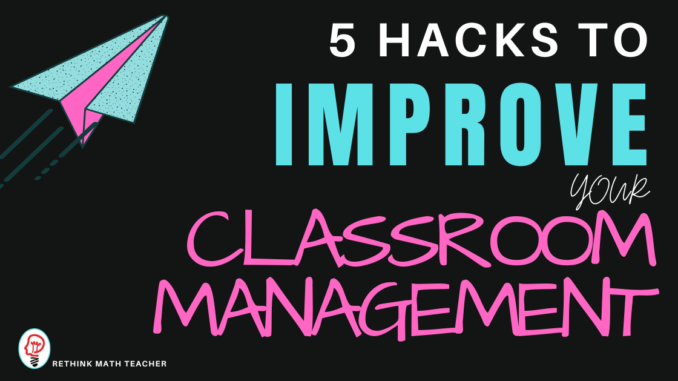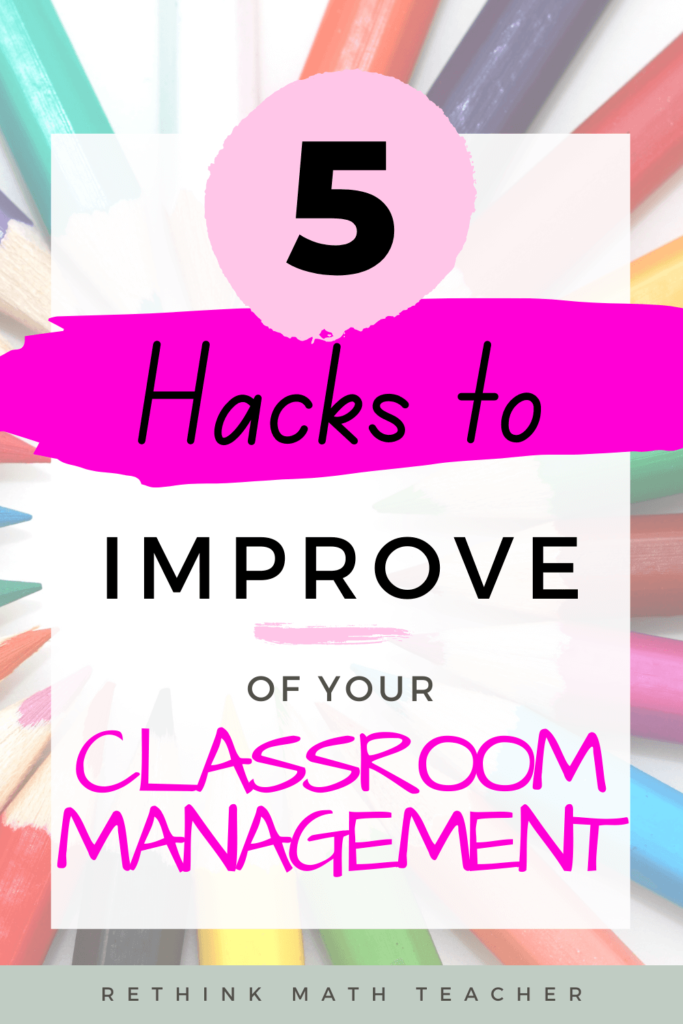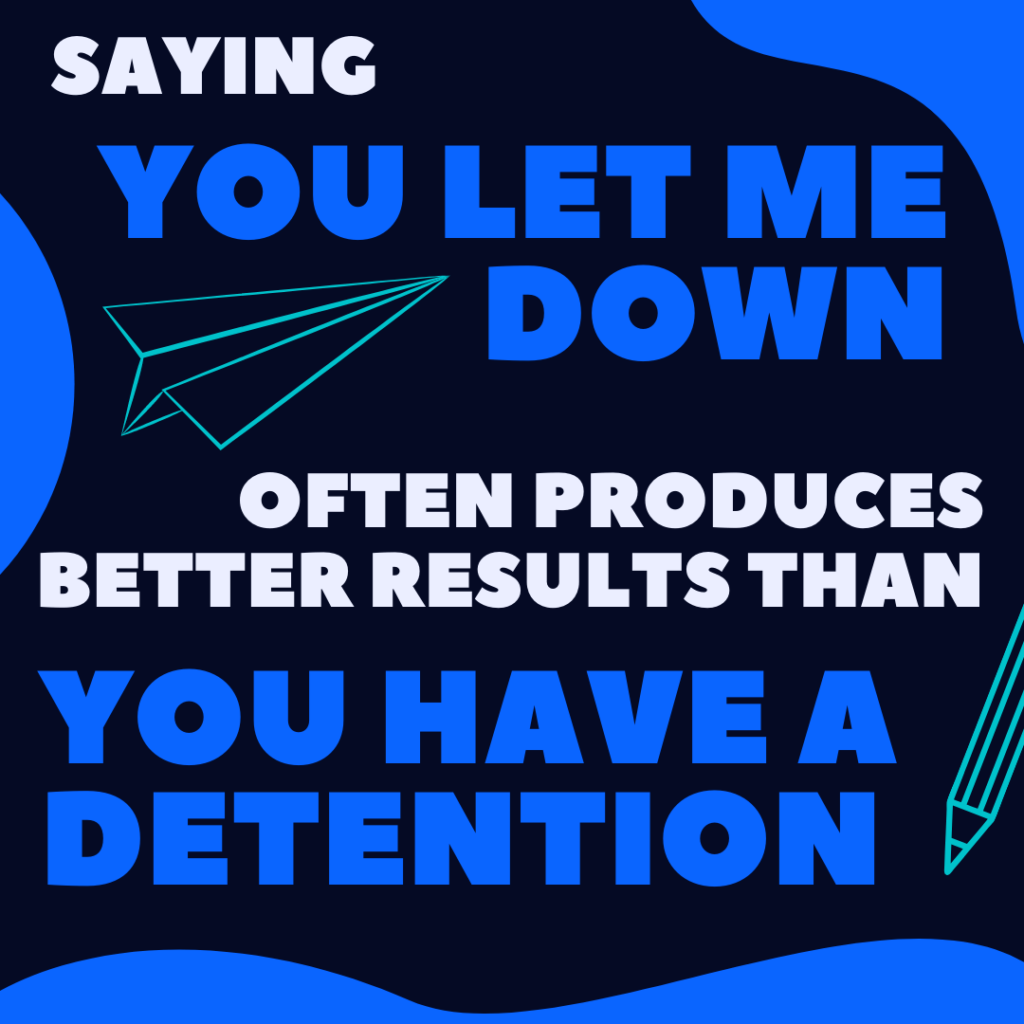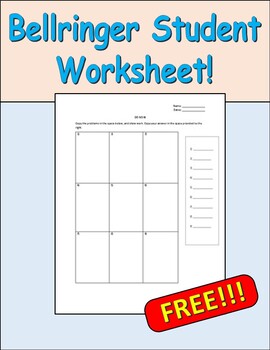
Whether your classroom management needs a little bit of help, or a lot, these five strategies are easy to implement and can make a major difference.
1 – Start Class Right
Beginning class correctly sets the tone for how the rest of the class will go. If students come into your classroom acting silly, misbehaving, or doing whatever they please – you will have to fight to overcome this the rest of the day. Instead, set the tone from the moment they enter the room, that this is a calm, safe place of learning.
From the moment your students cross the threshold, they should understand that their behavior has different expectations than it did in the hallway.
A few expectations you should have, and enforce, are that once students enter the room they have a set place to walk to and a set path to follow. For example, your entering the room routine might be that students enter the room, walk to their seat, take out their binder, and beginning working on the Bellringer (also called a Do Now).
Or, your routine might be that students walk to the backpack hooks or cubbies, put their backpacks in their designated place, take out their binder and homework, turn the homework into the bin, and then walk directly to their seat and begin working on the Do Now.
Whatever the routine is that you need to put in place, figure it out, write it down, teach it, have your students practice it, and then enforce it.
Consider what items your students will need for your class, such as notebook, writing utensil, stationary, homework, Do Now Worksheet, etc. Write these things down, and publish them in your room where your students can see it. Then review it with them, and have them practice it in class.
Yes, you need to clearly define and teach your students the path they are supposed to take. Whether it’s directly to their seats or to some other place in the room for a task (like putting away their coats or getting the resource bin), they need to know where to go – and where not to go.
You don’t want students wandering around the room, stopping at their friends’ desk, or doing anything other than the tasks you’ve outlined. Part of helping them find success in this expectation is helping them think through what they should and should not do. Clearly explaining the procedure for entering the room will help.
Next, you need to have something for your students to do once they have arrived at their seat with the correct supplies. This assignment or activity is called a Do Now (sometimes called a Bellringer).
The Do Now should be a short assignment, about five minutes, that students can do independently. It’s great if it consists of a review of prerequisite skills needed to do the task you are working on today. For example, if you are working on long division, it might be a review of short division or two-digit multiplication. If you are working on Bernoulli’s Principal, you could have students put piece of paper on top of two books spread apart (the paper would look like a bridge) and then have students try to blow the paper off. Then have them theorize why they can’t – getting them ready for the introduction of the material. Other good activities for a Do Now are journal entries, discovery questions or activities, grammar worksheets, vocabulary builders, or test style questions for review.
The Do Now assignment not only gives your students something to do, which lends to the learning environment you are creating, as well as lending to the upcoming lesson, but it also allows you to do all of the administrative tasks you need to do (like take roll and collect homework) quickly and without distraction.
For more information on how how to start class correctly, watch this video
2 – Don’t Let the Little Things Go
One of my favorite movie quotes about teaching is found in the movie Jurassic Park (the original one). In it, the park’s game warden, Robert Muldoon is explaining the behavior of the velociraptors – a very dangerous, yet intelligent dinosaur species. He said that the velociraptors would constantly throw themselves against the electric fences, “Testing it for any weaknesses.”
I think of the students in our classrooms when I hear this line.
The truth is that students actually like boundaries. We all do. They give us a sense of security. In classrooms where students are unaware of the boundaries, chaos soon ensues.
It’s natural for students to seek those boundaries – to throw themselves into those electric fences. They need to see that they are still there, rules still exist, and consequences will happen as a result of boundary-breaking.
When you establish a routine, procedure, or rule, you must stick to it. You must keep that barrier in place, or you must be the one to move it. You cannot let your students decide where the barriers are.
I often see teachers who notice an issue occurring in the classroom, and yet they ignore it, hoping it will go away, or that the students will self-correct. Unfortunately, the opposite is true. If one student stands up to throw his trash away, without correction, students will get the message that it’s okay to stand up and throw trash away. So more will do it.
Eventually, someone will stop at a friend’s desk along the way to the trash can to borrow a pencil or ask for an extra sheet of paper. This will also send a message to the class: that stopping at a friend’s desk to ask for supplies is okay. And on and on it goes.
Keep your boundaries firmly established, and don’t let the little things go. Snarky comments, shouting, not participating, and getting out of your seat are all not acceptable and must be addressed.
3 – Eliminate Distractions (standing up, pencil sharpening, bathroom pass issues)
One rule I firmly establish in my classroom is that students are not allowed to stand up.
If a student needs to get something out of their backpack, if they drop something on the floor, need to sharpen their pencil or throw something away… they may not stand up (without permission of course). And normally, I will take their trash from them to throw it away myself, hand them a pencil sharpener, pick their thing up off of the floor, or whatever else needs to be done to keep them in their seat.
I also don’t have electric pencil sharpeners in my room. I have handheld ones – usually on my desk and usually one in my pocket that I will hand to a student who needs to sharpen her pencil, and later I’ll return to retrieve it.
I have a host of other weird things like this that I do for one simple reason, I don’t want distractions.
When a student stands up and walks across the room to throw his paper ball away, what happens to the rest of the class? They all stop doing their work or listening to their teacher and watch the student. It’s human nature. An otherwise still and calm room has had its momentum disrupted by irregular movement, and our eyes and thoughts naturally investigate. This means we stop doing what we were doing, and when it’s concluded, and we’ve finished processing it, we have to return to what we were doing and try to regain our thoughts and pick back up where we left off.
Instead, eliminate these distractions and keep students on task. It will maximize learning as well as improve classroom management.

4 – Consistency is King (routines and procedures)
As previously mentioned, inconsistency will consistently lead to more inconsistency.
If you allow students to scoot their desks over to an unassigned place in the room, other students will soon do the same. If you allow a student to shout something out without raising her hand, other students will see this as acceptable behavior and follow suit.
Students will recognize what is and isn’t tolerated more aptly than what you tell them is and isn’t allowed (adults do this too).
So, set the proper expectations by clearly defining and reviewing the rules. Then, teach and practice those expectations. Finally, stay consistent. If something isn’t allowed, then don’t allow it! If you said ‘no talking while we’re doing independent work,’ then make sure that you don’t permit any talking.
5 – It’s all about Relationships
Finally, and perhaps most importantly, remember that relationships are king.
We got into teaching because we love young people and want to make a difference in their lives. Don’t lose sight of that while trying to get control of an unruly class.
When I coach teachers on implementing these strategies, and the five pillars of effective classroom management that I outline in my book, “Taking Control of Your Classroom Management,” teachers are often so zealous to rigorously enforce the strategies that they forget about the relationships. Yes, you have to quickly redirect or correct misbehavior, but don’t become someone you’re not in an attempt to gain control. And don’t lose your joy for your students when trying to establish your take control of you classroom management.
You don’t need to be a cruel monarch or a firm disciplinarian to keep your students in line. In fact, the opposite is likely more true – they will respond better to a kind, caring person. Often, saying, “You let me down,” will do more to correct behavior than, “you have a detention.”

If you would like more information on how to take control of your classroom management, a book that will help you recognize what rules, procedures, and routines you need to implement, as well as give you a detailed outline on how to implement these policies and procedures so that you can have a well run, and enjoyable class, check out my book: Taking Control of Your Classroom Management.




